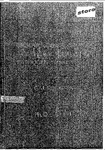Epidemiological studies of the bacterial fish pathogen Yersinia ruckeri
| dc.contributor.author | Rodgers, Christopher John | |
| dc.contributor.other | School of Biological and Marine Sciences | en_US |
| dc.date.accessioned | 2012-08-03T16:12:22Z | |
| dc.date.available | 2012-08-03T16:12:22Z | |
| dc.date.issued | 1991 | |
| dc.identifier | Not available | en_US |
| dc.identifier.uri | http://hdl.handle.net/10026.1/1112 | |
| dc.description.abstract |
A new mediumi, designated Ribose Ornithine Deoxycholate agar (ROD), was developed and used in field trials at two fish farms where fish were known to have ERM. The medium indicated that Yersinia ruckeri could occur in faeces four to six weeks before appearing in the kidney. Fxurther epidemiological studies dealing with fish condition, performance, disease signs and water isolation are presented. These factors are discussed in relation to husbandry and management practices. The minimum uihibitory concentration (MIC) values for 124 strains of F. ruckeri were detemuned. The effect of oxolinic acid, oxytetracycline and a potentiated sulphonamide, on growth patterns over a 72 h period, was also determined. Results showed the bactericidal or bacteriostatic nature of each antimicrobial agent. It was possible to increase the MIC for oxoUnic acid, oxytetracycline and a potentiated sulphonamide usmg an in vitro technique. Attempts to decrease resistance to oxolinic acid were unsuccessful. However, it was possible to reduce the MIC's for o^etracycline and a potentiated sulphonamide. The recovery of Y. ruckeri, after artificial challenge, was less from the faecal and kidney material of a vaccinated group of fish compared with a non-vaccinated group. An E L I S A technique indicated that although there was no detectable serum antibody there was a local mucosal response i n vaccinated fish. Uptake of F. ruckeri antigen was demonstrated in vaccinated and non-vaccinated fish using an immunoperoxidase technique. However, only vaccinated fish appeared to take up the antigen by an active process. A survey of salmonid farms showed that there was a tendency for those sites where ERM had been diagnosed, irrespective of vaccination, to be larger table farms with production ranging up to over 200 tonnes p:a. Certain environmental and husbandry factors were reported as coinciding with the appearance of F. ruckeri. A slight tendency to consider that vaccines had failed i n some way was also indicated. This and the use of antimicrobial agents are discussed. | en_US |
| dc.language.iso | en | en_US |
| dc.publisher | University of Plymouth | en_US |
| dc.title | Epidemiological studies of the bacterial fish pathogen Yersinia ruckeri | en_US |
| dc.type | Thesis | |
| dc.identifier.doi | http://dx.doi.org/10.24382/4530 | |
| dc.identifier.doi | http://dx.doi.org/10.24382/4530 |
Files in this item
This item appears in the following Collection(s)
-
01 Research Theses Main Collection
Research Theses Main


